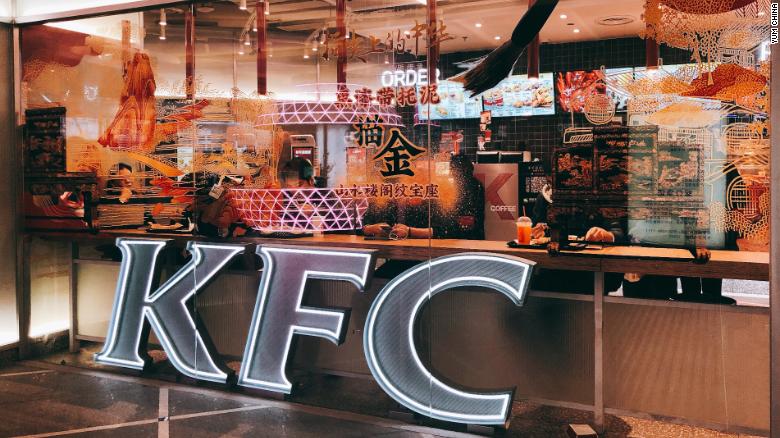Robot waiters and snail pizza: What US fast food brands do to please Chinese diners

Hong Kong, (DNA) – America’s fast food giants are having to work harder to win over dinersin China.
With more than 1.3 billion people, the country has driven sales at the likes of McDonald’s (MCD) and KFC in recent years.
The Chinese fast food industry is now worth $131 billion a year, according to research firm Euromonitor.
But things are getting tougher as the world’s second biggest economy slows and diners demand more. The response has been glitzier restaurants, bigger menus — and some pretty weird food.
KFC’s recipe for success
KFC is the biggest American fast food success story in China. The fried chicken chain entered the country more than 30 years ago, becoming its biggest player with 6,000 outlets. McDonald’s has about half that.
“By being the first Western fast food chain in China, it was an incredibly exciting offering purely by just being KFC,” said Andrew Atkinson, senior marketing manager at consulting firm China Skinny.
China is now the brand’s biggest global market, making up more than a quarter of global KFC sales. KFC’s operating profit in China grew 11% last year, according to the latest earnings from its parent company, Yum China (YUMC).
Chicken wings have proved extremely popular in China, but analysts say KFC’s success has been sustained by catering to Chinese tastes. Its menu is full of local foods such as congee (rice porridge), Chinese-style egg tarts and bubble tea.
More Chinese than Western
Many people in China now see KFC as “more of a Chinese than Western brand,” said Benoit Garbe, a senior partner at consulting firm Prophet based in Shanghai. The company has weathered setbacks in China, including a major food safety scandal in 2014 and a backlash against American brands in 2016.
It has also adapted to Chinese enthusiasm for ordering food for delivery or pickup on smartphone apps.
“They expect a mobile-first experience,” said Garbe.
KFC’s Chinese mobile app has more than 160 million users. More than two-thirds of orders in China are paid for through smartphones, according to the company.
Starbucks (SBUX) had to learn fast about theimportance of digital platforms for food and beverage brands. Facing fierce competition from local startup Luckin Coffee, which bases its business on online orders through its app, Starbucks teamed up with internet giant Alibaba (BABA) last year to offer a similar service.
Pizza Hut’s image problem
Pizza Hut is also owned by Yum China, but it has struggled to replicate KFC’s success.
The pizza chain has 2,000 restaurants in China. Last year, its revenue in the country declined 1% and operating profit slumped 38%. Unsuccessful efforts to woo Chinese diners have included offering exotic toppings like sea snails and deploying robot waiters.
Analysts say the brand has an image problem in China.
“If you were to ask young consumers in more sophisticated cities when they last had Pizza Hut, you’ll likely get a ‘maybe 10 years ago’ or ‘with my grandparents’ kind of response,” said Atkinson.
Yum China CEO Joey Wat said in December that the company is “not satisfied” with Pizza Hut sales and that profit margins at the business are likely to remain under pressure.
It’s now trying to fix things. Last year, Pizza Hut said that some restaurants would be fitted out with bars, open kitchens and larger dining areas to provide a more “modern and fashionable dining experience.”
“We are confident in our strategy and expect to see higher consumer satisfaction translating to improving performance in due course,” Wat said in December.
Analysts say the brand has an image problem in China.
“If you were to ask young consumers in more sophisticated cities when they last had Pizza Hut, you’ll likely get a ‘maybe 10 years ago’ or ‘with my grandparents’ kind of response,” said Atkinson.
Yum China CEO Joey Wat said in December that the company is “not satisfied” with Pizza Hut sales and that profit margins at the business are likely to remain under pressure.
It’s now trying to fix things. Last year, Pizza Hut said that some restaurants would be fitted out with bars, open kitchens and larger dining areas to provide a more “modern and fashionable dining experience.”
“We are confident in our strategy and expect to see higher consumer satisfaction translating to improving performance in due course,” Wat said in December.
« War should be against terrorism, not any country: John (Previous News)
Related News

Bill Gates to join major polio pledging moment at ADFW 2025
ABU DHABI, Dec 4 (WAM/APP/DNA):Abu Dhabi Finance Week (ADFW), hosted by ADGM, with headline partnerRead More

Kyrgyz President Zhaparov accorded guard of honour at PM House
ISLAMABAD, DEC 4 /DNA/: President of the Kyrgyz Republic Sadyr Nurgozhoevich Zhaparov on Thursday wasRead More


Comments are Closed